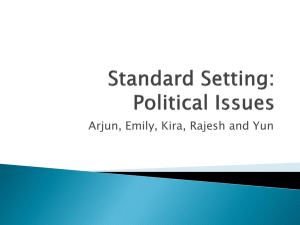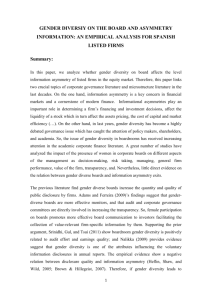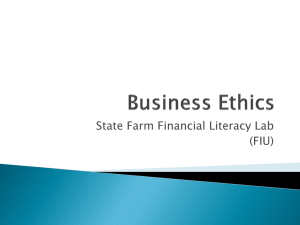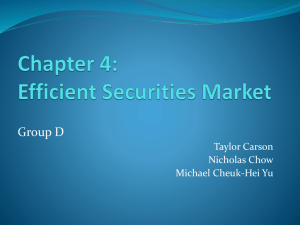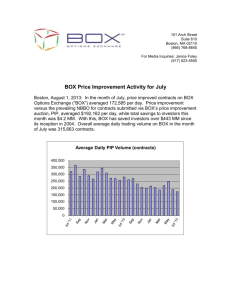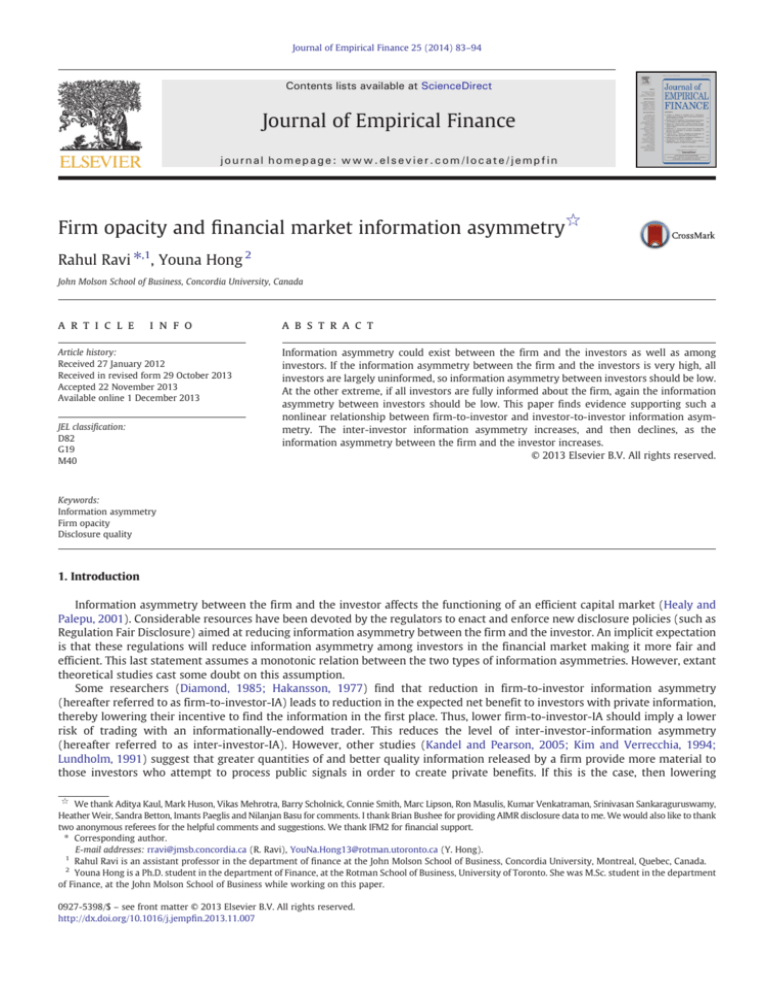
Journal of Empirical Finance 25 (2014) 83–94
Contents lists available at ScienceDirect
Journal of Empirical Finance
journal homepage: www.elsevier.com/locate/jempfin
Firm opacity and financial market information asymmetry☆
Rahul Ravi ⁎,1, Youna Hong 2
John Molson School of Business, Concordia University, Canada
a r t i c l e
i n f o
Article history:
Received 27 January 2012
Received in revised form 29 October 2013
Accepted 22 November 2013
Available online 1 December 2013
JEL classification:
D82
G19
M40
a b s t r a c t
Information asymmetry could exist between the firm and the investors as well as among
investors. If the information asymmetry between the firm and the investors is very high, all
investors are largely uninformed, so information asymmetry between investors should be low.
At the other extreme, if all investors are fully informed about the firm, again the information
asymmetry between investors should be low. This paper finds evidence supporting such a
nonlinear relationship between firm-to-investor and investor-to-investor information asymmetry. The inter-investor information asymmetry increases, and then declines, as the
information asymmetry between the firm and the investor increases.
© 2013 Elsevier B.V. All rights reserved.
Keywords:
Information asymmetry
Firm opacity
Disclosure quality
1. Introduction
Information asymmetry between the firm and the investor affects the functioning of an efficient capital market (Healy and
Palepu, 2001). Considerable resources have been devoted by the regulators to enact and enforce new disclosure policies (such as
Regulation Fair Disclosure) aimed at reducing information asymmetry between the firm and the investor. An implicit expectation
is that these regulations will reduce information asymmetry among investors in the financial market making it more fair and
efficient. This last statement assumes a monotonic relation between the two types of information asymmetries. However, extant
theoretical studies cast some doubt on this assumption.
Some researchers (Diamond, 1985; Hakansson, 1977) find that reduction in firm-to-investor information asymmetry
(hereafter referred to as firm-to-investor-IA) leads to reduction in the expected net benefit to investors with private information,
thereby lowering their incentive to find the information in the first place. Thus, lower firm-to-investor-IA should imply a lower
risk of trading with an informationally-endowed trader. This reduces the level of inter-investor-information asymmetry
(hereafter referred to as inter-investor-IA). However, other studies (Kandel and Pearson, 2005; Kim and Verrecchia, 1994;
Lundholm, 1991) suggest that greater quantities of and better quality information released by a firm provide more material to
those investors who attempt to process public signals in order to create private benefits. If this is the case, then lowering
☆ We thank Aditya Kaul, Mark Huson, Vikas Mehrotra, Barry Scholnick, Connie Smith, Marc Lipson, Ron Masulis, Kumar Venkatraman, Srinivasan Sankaraguruswamy,
Heather Weir, Sandra Betton, Imants Paeglis and Nilanjan Basu for comments. I thank Brian Bushee for providing AIMR disclosure data to me. We would also like to thank
two anonymous referees for the helpful comments and suggestions. We thank IFM2 for financial support.
⁎ Corresponding author.
E-mail addresses: rravi@jmsb.concordia.ca (R. Ravi), YouNa.Hong13@rotman.utoronto.ca (Y. Hong).
1
Rahul Ravi is an assistant professor in the department of finance at the John Molson School of Business, Concordia University, Montreal, Quebec, Canada.
2
Youna Hong is a Ph.D. student in the department of Finance, at the Rotman School of Business, University of Toronto. She was M.Sc. student in the department
of Finance, at the John Molson School of Business while working on this paper.
0927-5398/$ – see front matter © 2013 Elsevier B.V. All rights reserved.
http://dx.doi.org/10.1016/j.jempfin.2013.11.007
84
R. Ravi, Y. Hong / Journal of Empirical Finance 25 (2014) 83–94
firm-to-investor-IA may result in higher inter-investor-IA. Given the differing views, it is not clear whether a reduction in one
would lead to a decrease or an increase in the other.
Since theoretical arguments alone cannot unambiguously predict the relationship between firm-to-investor-IA and
inter-investor-IA, we look towards empirical research for some guidance. Most of the disclosure literature (Brown and
Hillegeist, 2007; Healy et al., 1999; Heflin et al., 2005; Welker, 1995) find a negative relation between disclosure quality and
information asymmetry among investors, as proxied by various measures of the bid–ask spread. Brown and Hillegeist (2007)
argue that this negative relationship exists because improved disclosure quality acts as a disincentive for investors searching for
private information, and therefore it reduces the probability of trading with informed traders in the market. This view is
consistent with the first of the two theoretical views outlined above (Diamond, 1985; Hakansson, 1977). However, evidence
from another set of studies, which includes Lee (1992), Lee et al. (1993), Krinsky and Lee (1996), Huson and MacKinnon (2003),
Ke and Ramaligegowda (2005), and Desaia and Savickas (2010), suggests a positive relation between disclosure quality and
information asymmetry among investors.
Huson and MacKinnon (2003), while studying the effects of focus enhancing spinoffs on inter-investor-IA, find that the
information asymmetry among investors increases post spinoff. To the extent that a focus-enhancing spinoff leads to
reduction in firm-to-investor-IA, their evidence supports the second theoretical view outlined above (Kandel and Pearson,
2005; Kim and Verrecchia, 1994; Lundholm, 1991). Desaia and Savickas (2010) draw a similar conclusion from their
evidence that the idiosyncratic volatility for parent firms increased after spinoffs and equity carve-outs. Exploring the post
earnings announcement adverse selection cost of trading (a measure of inter-investor information asymmetry), Lee et al.
(1993) and Krinsky and Lee (1996) find that, on average, the adverse selection cost component of the bid–ask spread
increases significantly after earnings announcements. Similar evidence has also been found in studies of post earnings
announcement drift trading strategies. Ke and Ramaligegowda (2005) document that the “transient” institutions that
arbitrage drift can trade on their ability to quickly process public disclosures into tradable private information. Their findings
suggest that differential private information can be created from public disclosures by investors with better processing
ability. Thus, once again, the extant research leaves us with differing views on the relationship between firm-to-investor-IA
and inter-investor-IA.
We attempt to reconcile the two diverging views by proposing a unimodal relation between the two types of information
asymmetries. This proposal draws its intuition from the theoretical model of Kim and Verrecchia (1991). Our contribution here is
to provide empirical evidence of a nonlinear and concave relation between the two types of information asymmetry that
potentially synthesizes seemingly conflicting extant research.
This line of reasoning is primarily motivated by Kim and Verrecchia (1991)'s work on the relation between the precision of
public announcement and inter-investor-IA. At one extreme, if the precision of the public announcement is low, disclosure causes
little expectation revision and thus few opportunities to trade. Consequently, there is little (additional) incentive for investors to
acquire private information in anticipation of a public announcement, so that information asymmetry across investors remains
small. At the other extreme, suppose that the precision of the public announcement is high. Here, the disclosure is of sufficient
magnitude to shock previous beliefs and price equilibrium. Hence, no opportunities are created for investors to trade. Again, there
is little (additional) incentive for investors to acquire private information, and therefore information asymmetry across investors
becomes small. Between these two extremes, the impact of the public announcement is sufficiently large to create opportunities
to trade, but it does not eliminate uncertainties to cause all beliefs and price to converge. Thus, information asymmetry across
investors becomes substantial. Therefore, according to this model, information asymmetry across investors increases as the
precision of the public announcement increases up to some point, and steadily decreases thereafter (that is, its behavior is
unimodal).
We test this prediction using a sample of over 1000 firms listed on NYSE from January 1993 to December 2008 and find
evidence in support of this hypothesis. As firm-to-investor-IA increases, inter-investor-IA increases up to some point, and steadily
decreases thereafter. This result is intuitively appealing. If a firm is completely transparent, all market participants would know
everything about the firm, hence, the inter-investor-IA should be zero.3 If the firm is completely opaque, all participants are
uninformed, hence, the inter-investor-IA should be close to zero. Somewhere between the two extremes, the information
asymmetry between investors attains a maximum.4
The result of this study has implications for a firm's transparency and disclosure-related policies. A marginal increase in the
level of transparency of a firm with very high firm-to-investor-IA could lead to an increase in its inter-investor-IA. This might lead
to reduced liquidity and possibly to a higher cost of capital (Amihud and Mendelson, 1988). The results suggest that increased
firm transparency might not necessarily be always advantageous to the average investor in the market. Thus, this study adds to
the literature on corporate disclosures policies. Furthermore, by pointing to a nonlinear relationship between firm-to-investor-IA
and inter-investor-IA, this study also provides a cautionary note to anyone using microstructure based information asymmetry
measures to proxy for firm-to-investor-IA.
3
A transparent firm is one with low to nil firm-to-investor-IA. As the level of firm-to-investor-IA declines, firms will become less transparent (or more opaque).
This paper uses transparency and firm-to-investor-IA synonymously. Opacity is the antonym of transparency.
4
A caveat is in order here. At the two extremes, the level of inter-investor-IA will be determined through the interplay of search costs associated with obtaining
private information and the economic value of the obtained private information. Therefore, the level of inter-investor-IA might be non-zero.

